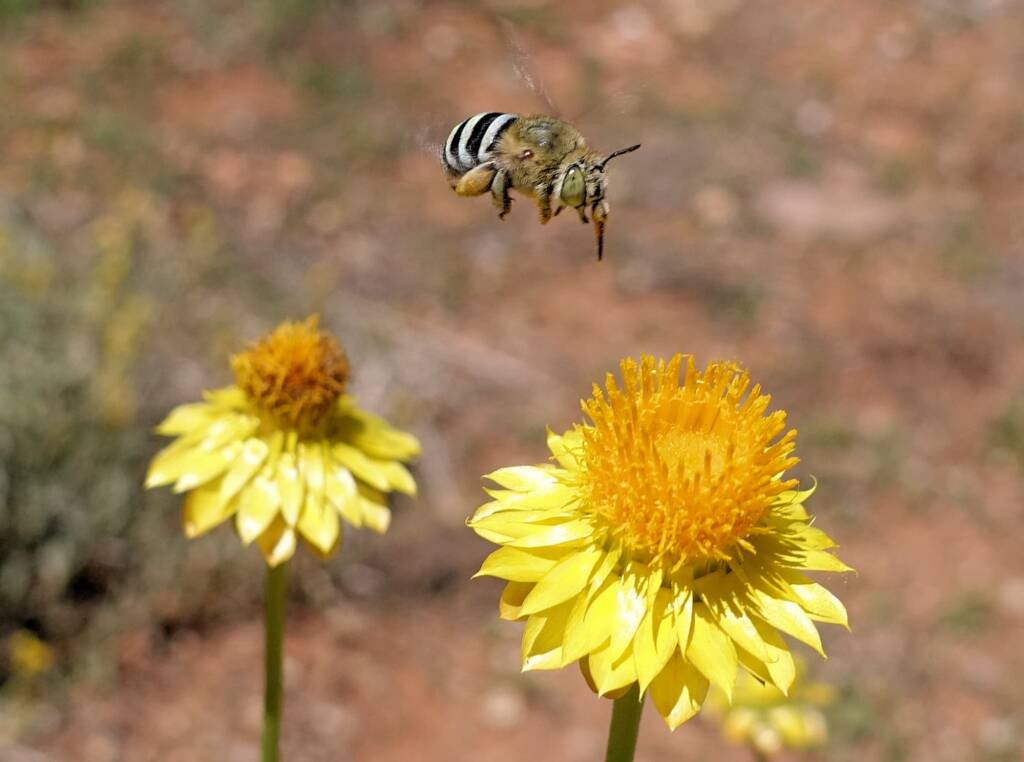Amegilla BeeApical tergites of females Amegilla Body Colour Amegilla adelaidae Amegilla aeruginosa Amegilla asserta Amegilla chlorocyanea Amegilla walkeri Teddy Bear Bees (Asaropoda)
There are over 250 species of Amegilla bees around the world. They are a group of native bee species that do not produce honey, but are very important pollinators of native plants and crops. This group of bees have a darting, hovering flight pattern.
The Amegilla bees are often commonly called “banded bees”, because of their characteristic striped abdomens, as well as having a golden-brown head. Sometimes they are referred to as the “blue banded bees”, and whilst some species do have the characteristic blue bands, there are some species who have different colour bands, such as white, yellow and green.

This group of bees are not considered aggressive, but can sting in defence. Their sting is mild, compared to the honey bee.
Being solitary bees, they live independently and nest in burrows in the soil, soft sandstone, even old motor and mud bricks. The male bees are seen to rest overnight by clinging to plant stems.
The following photograph is thought to be of the Amegilla (Notomegilla) chlorocyanea, being the dominant species in the Talbot Road Bushland Conservation Area, although the similar looking Amegilla (Zonamegilla) murrayensis is also in the region.

Blue Banded Bees
With over 250 species of blue-banded bees in the genus Amegilla, only a few actually possess blue bands on their abdomens. They are primarily those species belonging to the Notomegilla and Zonamegilla subgenera.
Although the common term “blue banded bees” is often used to describe the bees in the genus Amegilla, only a few of them have blue bands on their abdomen, primarily the species within the subgenera Notomegilla and Zonamegilla. It is a fact that they are not all blue. Some can be white, yellow, pale green and variations and mixes in between.
Pictured here is the species Amegilla chlorocyanea bee, commonly known as the Blue-banded Bee.

The Amegilla chlorocyanea bee seen on the Golden Everlasting (Xerochrysum bracteatum).







Check out some of our Blogging Bees… on Amegilla Bees by our bloggers:
- Scientific classification
- Kingdom: Animalia
- Phylum: Arthropoda
- Class: Insecta
- Order: Hymenoptera
- Family: Apidae
- Tribe: Anthophorini
- Genus: Amegilla
- Species: over 250 species
Footnote & References
- Alice Springs Field Naturalists Club Newsletter, February 2021, http://alicefieldnaturalists.org.au/21_02.pdf
- Blue Banded Bees, Western Sydney University, https://www.bluebandedbees.org/
- Aussie Bee, Australian Native Bee Research Centre, https://www.aussiebee.com.au/anbrc.html
- More Information on Blue Banded Bees (Amegilla), Aussie Bee, https://www.aussiebee.com.au/blue-banded-bee-information.html
- Blue Banded Bees, Western Sydney University, https://www.bluebandedbees.org/
Amegilla BeeApical tergites of females Amegilla Body Colour Amegilla adelaidae Amegilla aeruginosa Amegilla asserta Amegilla chlorocyanea Amegilla walkeri Teddy Bear Bees (Asaropoda)
BeesBees Anatomy Bee Behaviour Blogging Bees… Bees – image index Amegilla Bee Apis mellifera Austroplebeia australis Austrothurgus Braunsapis sp Ceylalictus perditellus Colletidae Euryglossinae Exoneura Homalictus Hyleoides bivulnerata Lasioglossum Lasioglossum (Chilalictus) Lipotriches Megachile Meroglossa Stenotritidae Tetragonula Thyreus Xylocopa
